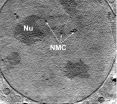The Western diet creates an acidic environment in the body that removes calcium from bones and may contribute to the development of osteoporosis. Healthy adults who consume the standard US diet sustain a chronic, low-grade state of acidosis that worsens with age as kidney function declines, limiting urinary acid excretion. Reto Krapf, MD (University of Basel, in Bruderholz/Basel, Switzerland) and colleagues designed a study to see if daily alkali as potassium citrate supplement tablets might neutralize these effects. They enrolled 201 healthy elderly individuals of both genders with normal bone mass in a randomized double-blind, placebo-controlled clinical trial. Participants received either 60 mmol alkali as potassium citrate (a base) or a placebo every day for 2 years. Bone density and high resolution computed tomography scans after 2 years revealed that neutralizing diet-induced acid production with potassium citrate significantly and safely increased subjects' bone density vs. placebo. "In addition, we discovered that bone architecture improved significantly, suggesting that not only bone mass, but also its quality was improved," said Dr. Krapf. These results suggest and predict that potassium citrate may be effective for preventing and even treating osteoporosis.
Study co-authors include Sigrid Jehle, MD (University of Basel, in Bruderholz/Basel, Switzerland) and Henry N. Hulter, MD (FibroGen, Inc., San Francisco).
Disclosures: The authors reported no financial disclosures.
The study abstract, "Long-Term Neutralization of Diet-Induced Acid Load by Kcitrate Increases Bone Density in Elderly Subjects with Normal Bone Mass: Results of a 2 Year Placebo-Controlled Trial," [F-FC236] will be presented as an oral presentation on Friday, November 19, 2010 at 5:18 PM MT in Room 605 of the Colorado Convention Center in Denver, CO.
2. The Wider the Waist as a Child, the Greater the Chance of Having a Risk Factor (High Pulse Pressure) Related to Heart Problems in Adults Waist Circumference Measurements May Be Better than Body Mass Index
A high pulse pressure—the difference between the systolic and the diastolic blood pressure readings—increases one's risk of heart-related disorders, as does high blood pressure, also known as hypertension. Gangadarshni Chandramohan, MD (Los Angeles BioMedical Research Institute at Harbor-UCLA Medical Center) and his colleagues investigated whether waist circumference in children might correlate with pulse pressure and provide a simple way to assess children's risk of later developing heart trouble. Investigators studied clinical and laboratory data from 4,667 children aged 6 to 17 years of age who were part of the Third National Health and Nutrition Examination Survey (NHANES III), conducted in the 1980s and 1990s on a nationwide sample of individuals. Children with a high waist circumference had significantly higher pulse pressures compared to children with a normal waist circumference. Body mass index did not show such a correlation. The authors advocate for measuring waist circumference (rather than body mass index) during routine physical examinations to identify children who are at risk for heart disease. "It is crucial that new indices for measuring various physiologic parameters such as obesity and associated cardiovascular risk factors be determined using valid, minimally invasive, and cost effective tools to help patients avoid long term health concerns," said Dr. Chandramohan.
Study co-authors include Kamyar Kalantar-Zadeh, MD, PhD (Los Angeles BioMedical Research Institute at Harbor-UCLA Medical Center); Sheena cecille marie Go (Harbor-UCLA Medical Center); Keith Norris, MD, and Dulcie Kermah (Charles Drew University School of Medicine).
Disclosures: Dr. Kanlantar-Zadeh is a consultant for Abbott, Amag, Amgen, BBraun, DaVita, Fresenius, Genzyme, GSK, Nutripletion, Sigma-Tau, Shire, and Watson; receives grants/research support from Abbott, DaVita, Shire, NIH, NIDDK, NKF; and receives honoraria from Abbott, Amag, Amgen, BBraun, DaVita, Fresenius, Genzyme, GSK, Nutripletion, Sigma-Tau, Shire, and Watson. Dr. Norris is a consultant for Davita; receives honoraria from Amgen, Merck, Monarch, Abbott, and Pfizer; and is a scientific advisor for Davita, Amgen, Abbott, and Monarch. The other authors reported no financial disclosures.
The study abstract, "Relationship between Waist Circumference and Pulse Pressure in Children: National Health and Nutrition Survey (NHANES) 1988-1994 Data," [F-FC222] will be presented as an oral presentation on November 19, 2010 at 4:30 PM MT in Room 601 of the Colorado Convention Center in Denver, CO.
3. Early Urine Test Predicts Pregnancy Complication Key Proteins in the Urine Indicate Increased Risk for Pre-eclampsia
Pre-eclampsia affects approximately 5% of pregnancies and can pose serious health concerns for mother and child. Some patients develop severe disease associated with kidney, liver, and neurological problems. The condition is characterized by high blood pressure and the loss of protein in the urine during the second half of pregnancy. Matt Hall, MBChB (Leicester General Hospital and the University of Leicester, United Kingdom) and colleagues conducted a study to see if analyzing the protein content of pregnant women's urine before the 20th week of pregnancy might predict pre-eclampsia. The researchers recruited 145 patients from a high-risk obstetric outpatient clinic; 11 (7.6%) developed pre-eclampsia, 10 at >37 weeks into the pregnancy and one at 31 weeks. An analysis of urine samples obtained prior to week 20 revealed a panel of 5 proteins that correctly predicted pre-eclampsia with 92% accuracy. "Our study suggests that changes in levels of certain proteins in the urine early in pregnancy can predict who will develop pre-eclampsia," said Dr. Hall. "Early identification will allow focused monitoring of those women and timely delivery of their babies, as well as reassurance for women at low risk."
Study co-authors include Paul Bosio, MD (Sandwell and West Birmingham NHS Trust, in Birmingham, the United Kingdom), Jonathan Barratt, MD, PhD; Nigel Brunskill, MD, PhD; Susan Carr MD (Leicester General Hospital and the University of Leicester); and Karen Molyneux, PhD (University of Leicester, in the United Kingdom).
Disclosures: The research was funded with pharmaceutical company support as well as clinical revenue support. The authors reported no other financial disclosures.
The study abstract, "An Early Pregnancy Urinary Proteomic Fingerprint Accurately Predicts Later Pre-Eclampsia," [F-FC223] will be presented as an oral presentation on November 19, 2010 at 4:42 PM MT in Room 601 of the Colorado Convention Center in Denver, CO.
###
ASN Renal Week 2010, the largest nephrology meeting of its kind, will provide a forum for 13,000 professionals to discuss the latest findings in renal research and engage in educational sessions related to advances in the care of patients with kidney and related disorders. Renal Week 2010 will take place November 16 – November 21 at the Colorado Convention Center in Denver, CO.
The content of this article does not reflect the views or opinions of The American Society of Nephrology (ASN). Responsibility for the information and views expressed therein lies entirely with the author(s). ASN does not offer medical advice. All content in ASN publications is for informational purposes only, and is not intended to cover all possible uses, directions, precautions, drug interactions, or adverse effects. This content should not be used during a medical emergency or for the diagnosis or treatment of any medical condition. Please consult your doctor or other qualified health care provider if you have any questions about a medical condition, or before taking any drug, changing your diet or commencing or discontinuing any course of treatment. Do not ignore or delay obtaining professional medical advice because of information accessed through ASN. Call 911 or your doctor for all medical emergencies.
Founded in 1966, the American Society of Nephrology (ASN) is the world's largest professional society devoted to the study of kidney disease. Comprised of 11,000 physicians and scientists, ASN continues to promote expert patient care, to advance medical research, and to educate the renal community. ASN also informs policymakers about issues of importance to kidney doctors and their patients. ASN funds research, and through its world-renowned meetings and first-class publications, disseminates information and educational tools that empower physicians.
END



